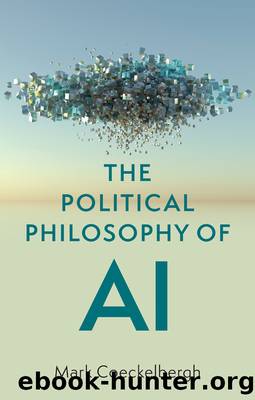The Political Philosophy of AI by Mark Coeckelbergh

Author:Mark Coeckelbergh [Coeckelbergh, Mark]
Language: eng
Format: epub
Published: 2021-10-07T00:00:00+00:00
While McQuillanâs way of seeing AI sounds too deterministic and risks unnecessarily assuming a strict opposition between humans and technology (humans also play a role), there is a significant danger that specific uses of AI â that is, specific combinations of AI and humans â contribute to shaping the conditions under which totalitarianism can grow and flourish.
The point about conditions is important. In order to avoid AI totalitarianism (and to maintain democracy), it is not sufficient to point to the responsibility of people in tech companies and governmental organizations and say that they should improve the design of the technology, the data, and so on. It is also necessary to ask the questions: what kind of social environment could be created that supports people to exercise this responsibility and makes it easier for them to question, criticize, or even resist when resistance is the right thing to do? What barriers can be created to hinder the described shifts from democracy to totalitarianism? And how can we create the conditions under which democracy can flourish?
The answer to these questions, of course, depends on the ideal of democracy (and politics); in this chapter, I have given an overview of some of these ideals and the tensions between them. But more work is needed to dig into the conditions that make democracy work. Here philosophy and the sciences (and the arts!) can collaborate. For example, inspired by Miessen and Rittâs (2019) volume on the spatial politics of right-wing populism, we may ask about the spatial and material conditions for democracy. What spaces would be good for democratic deliberation? And what kind of spaces could AI produce? How could AI help to create good architectures for democracy, literally and metaphorically? What kind of agora and public space do we need, not only conceptually but also very concretely, materially, and spatially? And what is the relation between, on the one hand, the political and the social and, on the other hand, material artifacts? For example, I have asked elsewhere (Coeckelbergh 2009a) what it would mean to speak of a âpolitics of artifactsâ: I questioned Arendtâs anthropocentric definition of the polis in The Human Condition , which assumes a strict distinction between humans and artifacts, but highlighted the importance of political events (the launch of Sputnik in her prologue) and retrieved the idea that for a public realm we need a common world that gathers us together, perhaps including somehow a âcommunity of thingsâ (Arendt 1958, 52â5). In chapter 6 , I will further discuss the idea of including non-humans within the political sphere and the role of hybridity in politics. More generally, we need to know more about the precise relations between, on the one hand, politics and the social and, on the other hand knowledge, space, and material technologies. We need to think through the conditions for democracy and the building of the public sphere in the light of new technologies and technological environments.
One way that political philosophy and philosophy of technology can contribute
Download
This site does not store any files on its server. We only index and link to content provided by other sites. Please contact the content providers to delete copyright contents if any and email us, we'll remove relevant links or contents immediately.
Practical Guide to Azure Cognitive Services by Chris Seferlis & Christopher Nellis & Andy Roberts(7103)
Unity Artificial Intelligence Programming - Fifth Edition by Dr. Davide Aversa(6718)
Serverless ETL and Analytics with AWS Glue by Vishal Pathak Subramanya Vajiraya Noritaka Sekiyama Tomohiro Tanaka Albert Quiroga Ishan Gaur(5312)
Open Source Projects - Beyond Code by John Mertic(4376)
Graph Data Modeling in Python by Gary Hutson and Matt Jackson(4359)
The AI Product Manager's Handbook by Irene Bratsis(4348)
Cloud Auditing Best Practices by Shinesa Cambric & Michael Ratemo(3998)
Aligning Security Operations with the MITRE ATT&CK Framework by Rebecca Blair(3992)
Graph Data Processing with Cypher by Anthapu Ravindranatha;(2148)
Data Literacy in Practice - A complete guide to data literacy and making smarter decisions with data through intelligent actions (2022) by Packt(2147)
Serverless Machine Learning with Amazon Redshift ML: Create, train, and deploy machine learning models using familiar SQL commands by Debu Panda Phil Bates Bhanu Pittampally Sumeet Joshi(2017)
Network Automation with Go by Nicolas Leiva & Michael Kashin(1965)
Unreal Engine 5 Game Development with C++ Scripting by Zhenyu George Li(1772)
Implementing Multifactor Authentication: Protect your applications from cyberattacks with the help of MFA by Marco Fanti(1629)
Applied Machine Learning and High-Performance Computing on AWS by Mani Khanuja | Farooq Sabir | Shreyas Subramanian | Trenton Potgieter(1366)
Data Literacy in Practice by Angelika Klidas Kevin Hanegan(1355)
Graph Data Processing with Cypher by Ravindranatha Anthapu(1332)
Fuzzing Against the Machine: Automate vulnerability research with emulated IoT devices on QEMU by Antonio Nappa Eduardo Blazquez(1207)
The AI Product Manager's Handbook: Develop a product that takes advantage of machine learning to solve AI problems by Irene Bratsis(1057)
